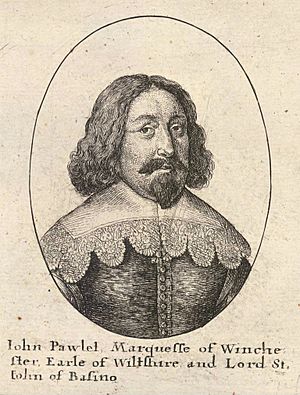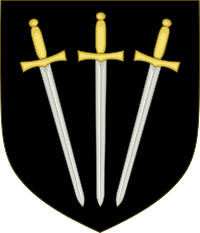John Paulet, 5th Marquess of Winchester facts for kids
Quick facts for kids John Paulet |
|
|---|---|
| Marquess of Winchester Earl of Wiltshire Baron St. John |
|
 |
|
| The Marquess of Winchester by Wenceslaus Hollar | |
| Coat of arms |  |
| Spouse(s) | Jane Savage Honora de Burgh Isabel Howard |
| Issue | |
| Charles Paulet, 1st Duke of Bolton | |
| [[]] | Paulet |
| Father | William Paulet, 4th Marquess of Winchester |
| Mother | Lucy Cecil |
| Born | 1598 |
| Died | 5 March 1675 (aged 76–77) |
| Burial | Englefield, Berkshire |
John Paulet, 5th Marquess of Winchester (born around 1598, died 5 March 1675), was an important English nobleman. He was known for his strong loyalty to King Charles I during the English Civil War. John Paulet inherited his title from his father, William Paulet, becoming the 5th Marquess of Winchester.
Contents
Early Life and Royal Connections
John Paulet studied at Exeter College, Oxford. However, because he was a Roman Catholic, he could not officially join the university. From 1620 to 1622, he served as a Member of Parliament for St Ives.
During the 1630s, he spent time away to improve his family's finances. By 1639, he returned to court and became a close friend of Queen Henrietta Maria. Because of this friendship, his main home, Basing House, became a popular meeting place for the Queen's friends in southwest England.
The English Civil War and Basing House
When the English Civil War began, John Paulet showed his strong loyalty to King Charles I. He prepared his home, Basing House, for battle. He added defenses and soldiers to protect it.
Basing House was attacked many times. The siege of Basing House lasted from August 1643 until October 1645. Even though his youngest brother, Lord Edward Paulet, tried to give the house to the enemy, John Paulet bravely defended it.
The Fall of Basing House
In October 1645, as the King's side was losing the war, Oliver Cromwell himself led the attack on Basing House. After a fierce fight, the house was captured. The way the house was attacked was very harsh. This might have been because there were several Catholic priests among the defenders.
John Paulet and the soldiers who survived were captured. Cromwell reported that they also took many cannons and ammunition.
Imprisonment and Release
After Basing House fell, John Paulet was sent to the Tower of London in 1645. He was held there for a long time. His wife, Lady Winchester, who had escaped Basing House just before it was captured, was also sent to join him in the Tower.
During his imprisonment, his family faced financial difficulties. His lands were ordered to be sold. However, in 1660, after the war ended and the King returned to power, the sale of his lands was stopped.
Restoration of the Monarchy
When the monarchy was brought back in England (known as the Restoration), John Paulet got his lands back. He was a symbol of loyalty to the King.
Family Life
John Paulet was married three times and had children from his first two marriages.
- His first wife was Jane Savage. They married in 1622.
- They had a son named Charles Paulet, 1st Duke of Bolton, who was born around 1630.
- Jane died in 1631 during childbirth. The famous poet John Milton wrote a poem about her.
- His second wife was Honora de Burgh. They married around 1645.
- They had a daughter named Anne, who later married John Belasyse, 1st Baron Belasyse.
- His third wife was Isabel Howard. They married in 1669.
Later Life and Legacy
John Paulet moved to Englefield House in Berkshire. This house was a wedding gift from his second marriage. He passed away on 5 March 1675 and was buried in Englefield, Berkshire.
His eldest son, Charles Paulet, became the 6th Marquess of Winchester. Charles later became the 1st Duke of Bolton. Charles decided to join the Church of England. This was a big change for the Catholic community in Hampshire. For many years, the Paulet family had helped protect them from strict laws against Catholics.
Images for kids
-
Jane, Marchioness of Winchester, painted by Gilbert Jackson in 1632.


